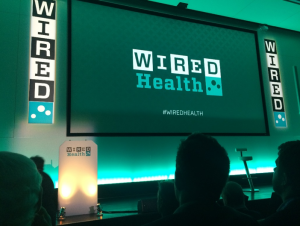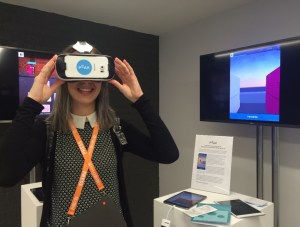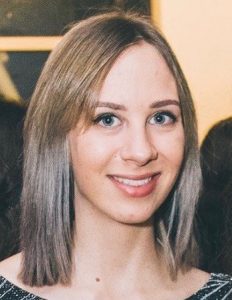On Friday 29th April 2016, WIRED Health returned to the Royal College of General Practitioners (RCGP) in London for a day filled with fascinating talks from 21 speakers from around the word. Alongside the speakers, the event featured an exhibition of the latest advances in health technology, giving us a glimpse of what the future could hold for the healthcare industry. I was fortunate enough to receive a scholarship from the new Hull York Medical School (HYMS) Student Blog to attend the event.
Unlocking the brain
One of the main themes of the day was unlocking the mysteries of the brain. Despite the countless years of research and great progress in our understanding, this fascinating organ still holds much to be discovered. Throughout the day, we heard from people at the forefront of neuroscience, who are involved in developing new technologies to unlock the potential of the brain, and in devising therapeutic treatments for a wide range of diseases.
 One of my favourite presentations came from John Donoghue, Founding Director of the Wyss Center for Bio- and Neuroengineering and Professor of Neuroscience and Engineering at Brown University, Rhode Island. Current projects at Wyss include developing a bionic eye, engineering genes to prevent hearing loss, and reshaping brain circuits to cure dyslexia. However, Dr Donoghue’s talk at WIRED focused mainly on his work as part of the BrainGate research team, which is trialling a neural interface system that enables people who are paralysed to control robotic limbs using their minds. Donoghue explained how his team developed microelectrodes, which can be implanted on the brain, to allow tetraplegic patients to wirelessly transmit their thoughts in order to control a robotic arm. He showed us a video of a woman named Cathy, who was left paralysed after a brainstem stroke, using a robotic arm to feed herself for the first time in years. The company is looking to develop this technology further to allow paralysed people to move their own limbs. The final stages of development are some way off, but this gives hope to paralysed patients that someday in the future they may once again be able to control their own body.
One of my favourite presentations came from John Donoghue, Founding Director of the Wyss Center for Bio- and Neuroengineering and Professor of Neuroscience and Engineering at Brown University, Rhode Island. Current projects at Wyss include developing a bionic eye, engineering genes to prevent hearing loss, and reshaping brain circuits to cure dyslexia. However, Dr Donoghue’s talk at WIRED focused mainly on his work as part of the BrainGate research team, which is trialling a neural interface system that enables people who are paralysed to control robotic limbs using their minds. Donoghue explained how his team developed microelectrodes, which can be implanted on the brain, to allow tetraplegic patients to wirelessly transmit their thoughts in order to control a robotic arm. He showed us a video of a woman named Cathy, who was left paralysed after a brainstem stroke, using a robotic arm to feed herself for the first time in years. The company is looking to develop this technology further to allow paralysed people to move their own limbs. The final stages of development are some way off, but this gives hope to paralysed patients that someday in the future they may once again be able to control their own body.
Vincent Walsh, Professor of Human Brain Research at University College London, was one of the next speakers to take to the stage. Professor Walsh has an impressive array of achievements: he works with Team GB athletes, and has published over 300 scientific papers and several books. He talked about his work using magnetic and electrical brain stimulation in the treatment of depression and sleep disorders. Making himself comfortable on the chair onstage, his talk had a different feel to the other presentations of the day; it seemed almost as though we were part of a conversation amongst friends. The regular rumbles of laughter from the audience confirmed just how much delegates enjoyed his presentation, but alongside the humour his talk was peppered with words of wisdom on self-improvement.
“Gifts only ever come from hard work.” – Vincent Walsh, WIRED Health 2016
Synthesising human tissues
Jo Mountford, Head of Tissue and Cellular Therapeutics RDI at the Scottish National Blood Transfusion Service, gave a presentation on her recent work trialing ‘lab-grown blood’, for which she received £5 million in funding from the Wellcome Trust. Having heard from Jeremy Farrar, Director of the Wellcome Trust, earlier in the day, it was nice to see where some of the £700 million of funding they provide each year was being used. One advantage of lab-grown blood is that, unlike a normal bag of donated blood, all of the red cells will be young and freshly produced with no variation in the age of the cells. This means that the transfused blood will last longer in a recipient. Although we are still a long way off replacing the traditional method of blood donations, the end goal of this project is to create an endless supply of clean, safe blood, grown from pluripotent stem cells that can be made from any tissue in the body and then differentiated into red cells.
Also presenting was Geraldine Hamilton, President & Chief Scientific Officer at Emulate. Dr Hamilton led the Organs-on-Chips programme at the Wyss Institute for Biologically Inspired Engineering, a system which models human biology and could potentially replace human and animal test subjects. Her team are aiming to connect 10 different organ chips and link them together to emulate an entire human-body response. The Organs-on-Chips project won London Design Museum’s 2015 Design of the Year competition.
Science meets art

Just as my brain was almost overloaded from the incredible technology I was hearing about, we took a break from the hard science and explored the role of art in healthcare. Art and science are certainly not mutually exclusive fields, and science fiction artist Lucy McRae is proof of this. Lucy gave a brilliant talk on her recent projects, which include electronic tattoos implanted under the skin that create an image when you touch them, and swallowable perfume in the form a pill that is metabolised and excreted through sweat glands when you perspire. She told us about some of the moving messages she had received from patients with hyperhidrosis, or excessive sweating, explaining how she had given them hope. Lucy showed that science and art can go hand in hand to make a difference to people’s lives.
The exhibition
The area outside the auditorium held the exhibition of the latest developments in health technology. Every turn presented another chance to test out virtual reality headsets, an opportunity I took full advantage of before becoming too dizzy and being forced back into the real world. There were plenty of breaks throughout the day to get chatting with both the speakers and other delegates. I was lucky enough to meet the lovely Josh Stephenson, one of the speakers of the day, who had part of his jaw and face reconstructed after radical surgery to treat malignant melanoma. Josh showed me a 3D printed version of his skull, which he happened to have in his bag with him.
The Start-Up Stage

Alongside the main stage of speakers was the BUPA Start-Up Stage, giving 18 companies a chance to explain and promote their products and services. A panel of judges then selected one winner to present their talk on the main stage at the end of the day. This year, the winning start-up presenter was Ivana Schnur from Sensely, a digital healthcare company based in San Francisco. Once you have downloaded the company’s app, you can speak to Olivia, a virtual nurse. Olivia is multilingual and is able to hold a conversation with you, much like a real-life consultation with a nurse. Dr Schnur gave a full demonstration of Olivia’s capabilities on her iPad in front of the audience. This impressive demonstration of her work captivated the audience and I believe she was a worthy winner.
I thoroughly enjoyed my day at WIRED Health, and would encourage anyone with an interest in the future of healthcare and health technology to attend the event next year. I heard from some fascinating speakers, played with some impressive technology, and met a whole host of lovely people.
Thank you to the organisers of WIRED Health, particularly João Medeiros, for having me, and hosting a fantastic event. Thanks to Alex Abel for securing this scholarship opportunity. I thoroughly enjoyed my experience, and would encourage all HYMS students to apply for future Student Blog scholarship opportunities.
 Grace Gawn is a second year medical student at HYMS. She can usually be found with a cup of tea and/or a burrito in her hand, getting stuck into a good TV series.
Grace Gawn is a second year medical student at HYMS. She can usually be found with a cup of tea and/or a burrito in her hand, getting stuck into a good TV series.

